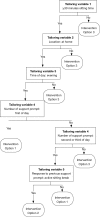The conceptualization of a Just-In-Time Adaptive Intervention (JITAI) for the reduction of sedentary behavior in older adults
- PMID: 29184889
- PMCID: PMC5682389
- DOI: 10.21037/mhealth.2017.08.05
The conceptualization of a Just-In-Time Adaptive Intervention (JITAI) for the reduction of sedentary behavior in older adults
Abstract
Low physical activity and high sedentary behavior in older adults can be addressed with interventions that are delivered through modern technology. Just-In-Time Adaptive Interventions (JITAIs) are an emerging technology-driven behavior-change intervention type and capitalize on data that is collected via mobile sensing technology (e.g., smartphones) to trigger appropriate support in real-life. In this paper we integrated behavior change and aging theory and research as well as knowledge around older adult's technology use to conceptualize a JITAI targeting the reduction of sedentary behavior in older adults. The JITAIs ultimate goal is to encourage older adults to take regular activity breaks from prolonged sitting. As a proximal outcome, we suggest the number of daily activity breaks from sitting. Support provided to interrupt sitting time can be based on tailoring variables: (I) the current accumulated sitting time; (II) the location of the individual; (III) the time of the day; (IV) the frequency of daily support prompts; and (V) the response to previous support prompts. Data on these variables can be collected using sensors that are commonly inbuilt into smartphones (e.g., accelerometer, GPS). Support prompts might be best delivered via traditional text messages as older adults are usually familiar and comfortable with this function. The content of the prompts should encourage breaks from prolonged sitting by highlighting immediate benefits of sitting time interruptions. Additionally, light physical activities that could be done during the breaks should also be presented (e.g., walking into the kitchen to prepare a cup of tea). Although the conceptualized JITAI can be developed and implemented to test its efficacy, more work is required to identify ways to collect, aggregate, organize and immediately use dense data on the proposed and other potentially important tailoring variables. Machine learning and other computational modelling techniques commonly used by computer scientists and engineers appear promising. With this, to develop powerful JITAIs and to actualize the full potential of modern sensing technologies transdisciplinary approaches are required.
Keywords: Physical activity; behavior change; eHealth; mHealth; smartphone.
Conflict of interest statement
Conflicts of Interest: The authors have no conflicts of interest to declare.
Figures



Similar articles
-
Behavioral response to a just-in-time adaptive intervention (JITAI) to reduce sedentary behavior in obese adults: Implications for JITAI optimization.Health Psychol. 2015 Dec;34S(0):1261-7. doi: 10.1037/hea0000304. Health Psychol. 2015. PMID: 26651467 Free PMC article.
-
Exploring the Acceptance of Just-in-Time Adaptive Lifestyle Support for People With Type 2 Diabetes: Qualitative Acceptability Study.JMIR Form Res. 2025 Feb 19;9:e65026. doi: 10.2196/65026. JMIR Form Res. 2025. PMID: 39969969 Free PMC article.
-
A Personalized Smartphone-Delivered Just-in-time Adaptive Intervention (JitaBug) to Increase Physical Activity in Older Adults: Mixed Methods Feasibility Study.JMIR Form Res. 2022 Apr 7;6(4):e34662. doi: 10.2196/34662. JMIR Form Res. 2022. PMID: 35389348 Free PMC article.
-
A systematic review of just-in-time adaptive interventions (JITAIs) to promote physical activity.Int J Behav Nutr Phys Act. 2019 Apr 3;16(1):31. doi: 10.1186/s12966-019-0792-7. Int J Behav Nutr Phys Act. 2019. PMID: 30943983 Free PMC article.
-
Personalized interventions for behaviour change: A scoping review of just-in-time adaptive interventions.Br J Health Psychol. 2025 Feb;30(1):e12766. doi: 10.1111/bjhp.12766. Epub 2024 Nov 14. Br J Health Psychol. 2025. PMID: 39542743 Free PMC article.
Cited by
-
Privacy-Preserving Methods for Feature Engineering Using Blockchain: Review, Evaluation, and Proof of Concept.J Med Internet Res. 2019 Aug 14;21(8):e13600. doi: 10.2196/13600. J Med Internet Res. 2019. PMID: 31414666 Free PMC article. Review.
-
Adaptive Intervention Designs to Promote Behavioral Change in Adults: What Is the Evidence?Curr Diab Rep. 2019 Jan 25;19(2):7. doi: 10.1007/s11892-019-1127-4. Curr Diab Rep. 2019. PMID: 30684109 Review.
-
Personalizing mHealth Interventions for Occupational Stress: Protocol for a Randomized Pilot Study.JMIR Res Protoc. 2025 Jun 3;14:e68012. doi: 10.2196/68012. JMIR Res Protoc. 2025. PMID: 40460419 Free PMC article.
-
Smartphone-Based Interventions to Reduce Sedentary Behavior and Promote Physical Activity Using Integrated Dynamic Models: Systematic Review.J Med Internet Res. 2021 Sep 13;23(9):e26315. doi: 10.2196/26315. J Med Internet Res. 2021. PMID: 34515637 Free PMC article.
-
The Association of Meteorological Factors with Cognitive Function in Older Adults.Int J Environ Res Public Health. 2021 Jun 2;18(11):5981. doi: 10.3390/ijerph18115981. Int J Environ Res Public Health. 2021. PMID: 34199578 Free PMC article.
References
-
- Bloom DE, Canning D, Lubet A. Global population aging: facts, challenges, solutions & perspectives. Daedalus 2015;144:80-92. 10.1162/DAED_a_00332 - DOI
-
- United Nations, Department of Economic and Social Affairs, Population Division. World Population Ageing 2013. New York: United Nations Publications, 2013.
-
- Rowe JW. Successful aging of societies. Dædalus 2015;144:5-12. 10.1162/DAED_a_00325 - DOI
Publication types
LinkOut - more resources
Full Text Sources
Other Literature Sources
Research Materials
